how to play piano
So you want to find out more about piano for beginners?
Learning the piano can seem like a massive mountain to climb. As part of our ‘Beginner’s Guide To Learning Piano’ series, this section will help you start your journey by giving you the basics to get you going…

Configuration of keys
There may be 88 notes on a piano, but there are in fact only twelve to learn!
Let’s break the piano down into more manageable pieces. If you look closely at the keyboard, you’ll see there is a pattern; the twelve keys repeat themselves in the same configuration up and down the instrument. We call this sequence of twelve keys an ‘Octave’. Learning to identify this octave pattern is crucial for finding your way around the keyboard.
To help you find your starting point, look at the black keys. You will notice an alternating pattern: groups of two and three black keys.
The keys are named after letters of the alphabet. Every white key immediately to the left of a group of two black keys is a C. Find the middle of the keyboard, and the C to the left of the group of two black keys. This is what we call middle C.
Once you have found middle C, place your right thumb on it. Now put the rest of your fingers on the keys up from middle C, assigning one finger to each of the next four white keys. These are D, E, F, and G.

This position will be your starting point for playing your first few tunes. Ignore the black keys for now; we will come to them later…
The two notes below C, heading down the piano, are A and B. Since there are only seven different white keys, we only use the first seven letters in the alphabet: A to G. In other words, the white key that comes after G is an A. The whole sequence then starts again.
So, you’re now wondering why we start learning on a C, and not at the beginning of the alphabet on an A… Well, the simple reason is that many songs for beginners can be played easily in the C position with only white keys.
So your first task is...
to get comfortable knowing which key is which letter of the alphabet! Practice playing C to G and back again, pressing only one note down at a time, and keeping all the other fingers as still as possible. It sounds simple. It’s not…
What number finger is what?
When learning the piano, we rely upon naming each finger a number, so we can accurately give instructions. Your thumbs on both hands are number one, and the count outwards to your little pinky finger, which is finger number five.
If you see any numbers above or below notes, those numbers will correlate as to what finger you should use.
Other languages
This system is called the ‘English notation system’. It is the standard used today across most of the world. However, you will always find some countries and people using a different system.
The second most popular system is called the ‘Fixed Do system’. You’ll have heard it from the song ‘Do Re Mi’ from ‘The Sound of Music’. Instead of C, D, E, F, G, A, B, this notation uses Do, Re, Mi, Fa, Sol, La, Si.
Playing Scales
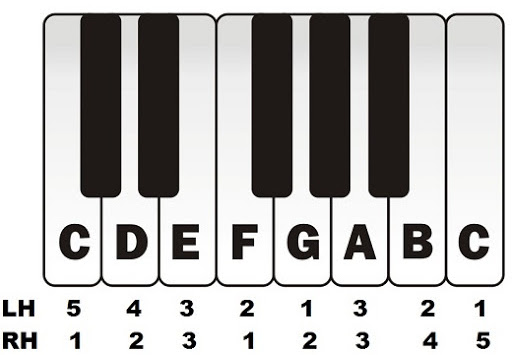
Now that you know the numbers for your fingers and the names of the notes, you can apply your learning to play a C major scale. The C major scale consists of eight notes from C to the C. Now as you only have five fingers on each hand, this means you’ll need to do a special thumb ‘tuck’ movement to be able to play all eight notes smoothly.
The fingering pattern in the right hand is 1, 2, 3, (TUCK) 1, 2, 3, 4, 5. A thumb tuck involves curling your thumb under your hand, so it tries to reach finger number five. Although it may seem simple, the thumb tuck is one of the essential skills a pianist needs to learn, so don’t skip over this bit!
One bad habit to be aware of is the ‘elbow kick’. When you tuck your thumb, don’t kick out your elbow. It’s a very bad habit (one that our Founder Robert Emery had when he was a beginner!) that is difficult to fix later on…
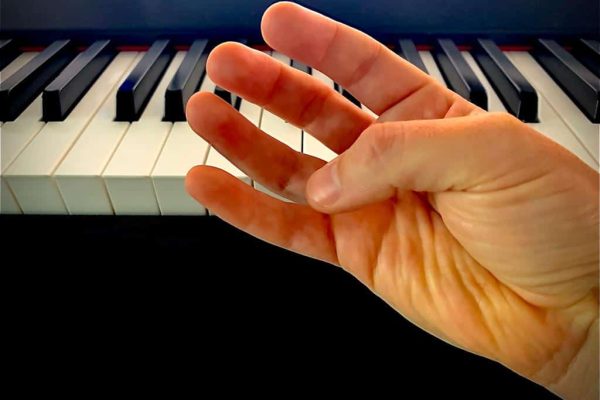
When practicing scales in the left hand, all the same rules apply, except our hands are mirrored. This means the fingering pattern is 5, 4, 3, 2, 1, (OVER) 3, 2,a 1.
This time, instead of a TUCK, we do an OVER. This is where the thumb tucks under the hand, exactly like you’ve already learnt, but the third finger moves your hand up to play the A note.
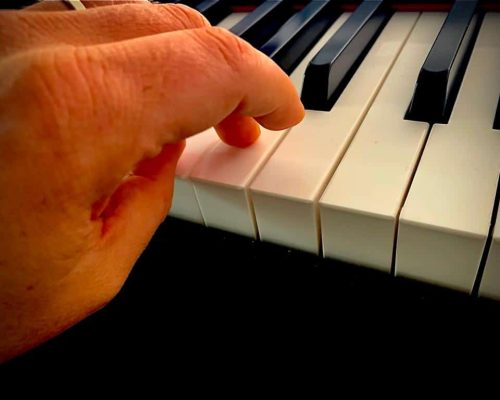
Playing Chords
Chords are a significant component of most music. They are so crucial that you shouldn’t avoid them.
What is a Chord?
A chord is a group of three notes, from the same scale, that create a specific, pleasant sound when played together. Simple as that!
Chords form the basic sound of all popular music, and most classical music too. The quicker you get to know what the chords are, the faster you’ll realise that most popular music is made up of a simple structure, that can be repeated across different songs.
Difference between a triad and a chord?
So what is the difference between a triad and a chord? Well this is a very complicated answer. None. Absolutely nothing.
Major Chords
Minor Chords
Other Chords
Major Chords
These are called ‘the happy’ chords. They sound natural and pleasant to the ear.
Think of your national anthem. That’s in a major key, sounds happy and like all is good in the world. Therefore it’s mostly made up of major chords.
Minor Chords
Think sad. Very sad.
If you know the Beethoven ‘Moonlight’ Sonata, that’s in a minor key, featuring lots of minor chords (broken chords to be precise).
Another example is horror music in films. Anything that has a scary castle with smoke and only candles for light is bound to have minor music underneath!
Other Chords
Nothing in life is that easy, and chords are no exception! There are lots of varieties of chords; all of which form the ‘cherry on the top’ of the cake, and not the cake itself.
Therefore don’t worry about the other chords right now. Everything in good time…
How are chords identified?
Each chord has a name. C Major is a good example. That is telling me the ‘root’ of the chord, or the bass foundation of the chord, is in the scale of C. This means the first note of the chord is C.
The ‘major’ bit is telling me it’s the happy version of the C chord.
C Minor is exactly the same chord as C Major, but it’s the sad version. To make it sound sad, we swap the middle note of the chord for the nearest note on the left – regardless of if that note is a white note or black.
How many chords are there?
There are twelve chords in each variety. So twelve major chords, twelve minor chords etc. There are many variations of the twelve chords (we’re just being honest!) – in fact there are 4017 in total (!), but we don’t need to worry about those variations just yet.
Major Chords
There is a secret to chords – they follow a formula. Yes, a bit of very easy maths is involved. But once you know this secret, you can apply it to any chord, and you’ll know how to play it immediately.
So what is this formula?
4 then 3
From the bottom note, you count up (NOT including the note you are on) four. That then gives you the next note to add into your chord.
You now have two notes. To find the next and final note, you count up three – NOT including the one you are on.
4 then 3. Is it really that simple? Yes it is! There are only two rules.
- You must count up four and then three not including the note you are currently on.
- Black notes as well as white are included in this. So it’s not counting up four white notes – it’s counting up four notes regardless of colour!
To prove it, here is a C Major chord. You’ll see the bottom note is C. Count up four notes and you get an E. Count up three notes and you get a G.
C Major
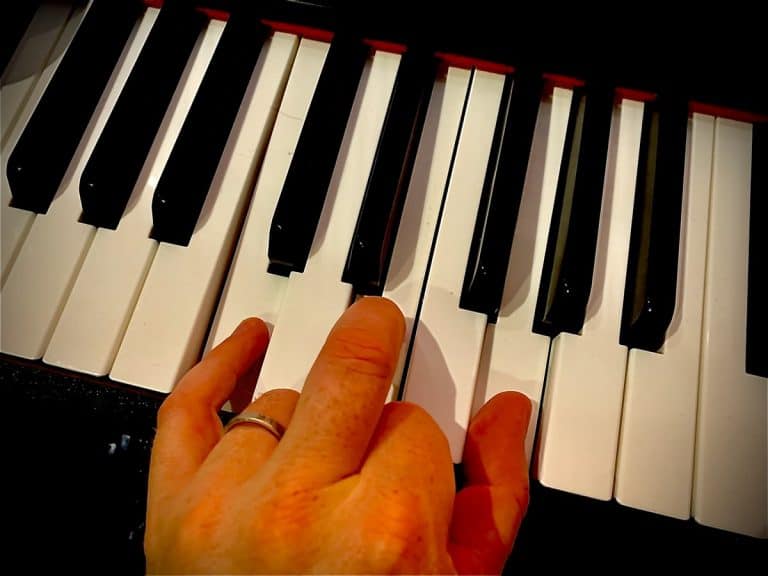
E Major
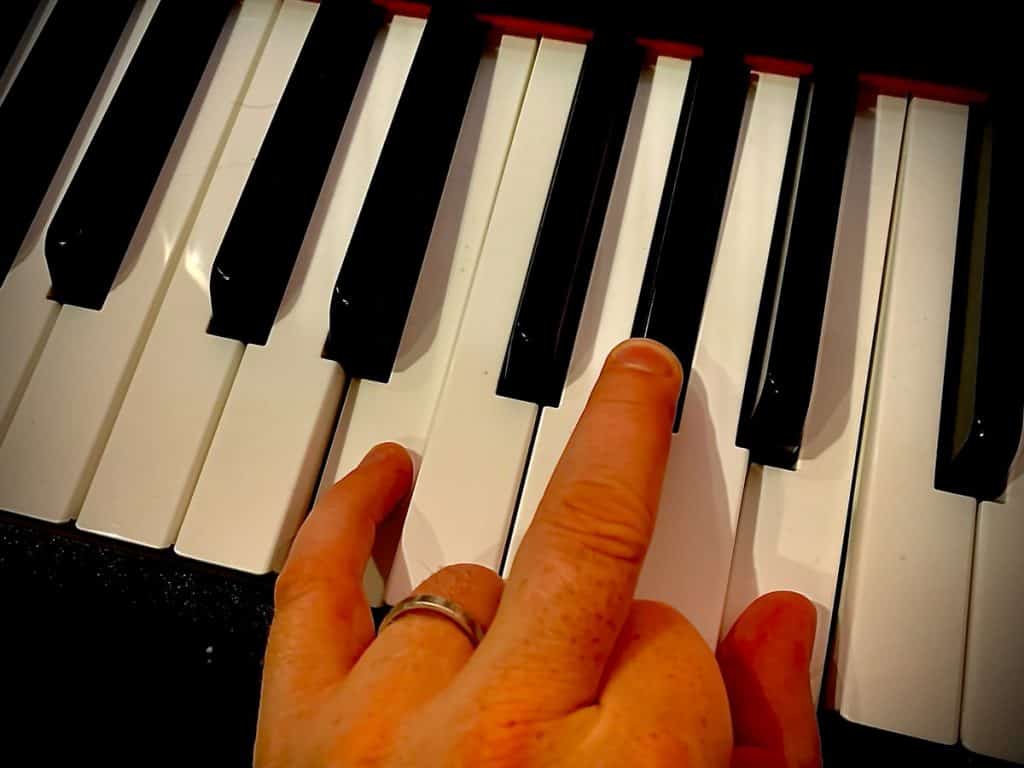
To doubly prove how easy it is, here is an E Major chord. Do the same formula.
4 then 3. Yes this example contains a black note – but just because it’s a different colour doesn’t make it harder to understand!
E Major = E – G# – B
F# Major
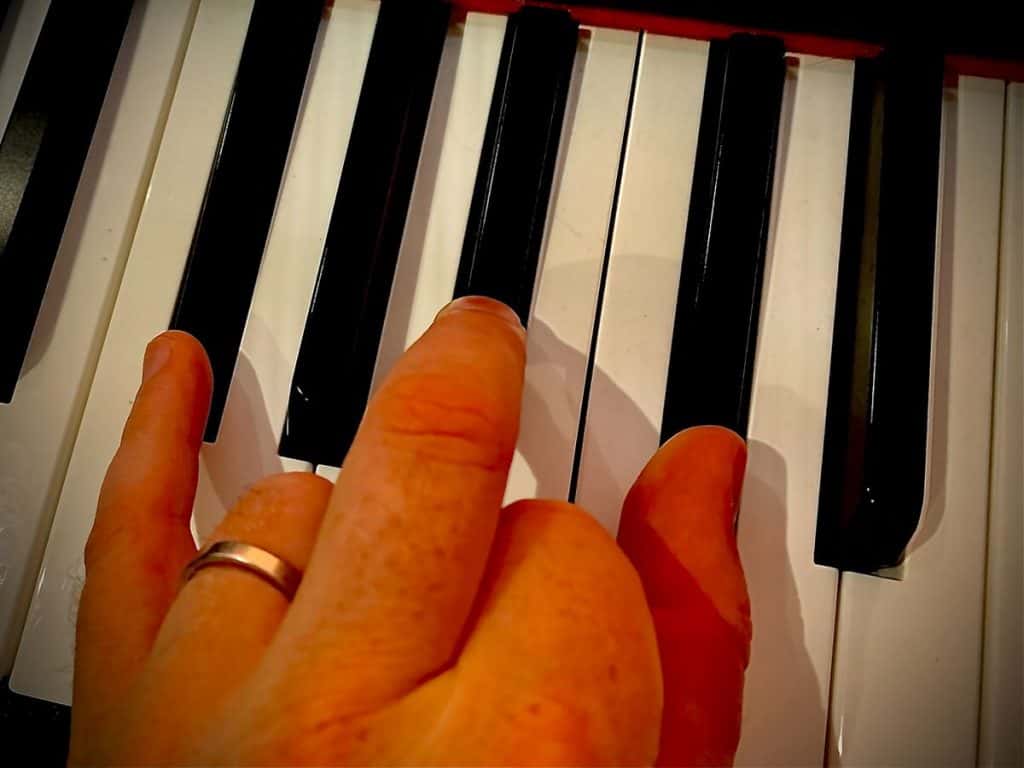
To triply (I’m not sure if that’s even a word!) prove how easy this is, this chord is an F# Major chord. Allegedly one of the trickiest chords to play.
Start on F#. Count four then three, and you have the correct chord!
F# Major = F# – A# – C#
Minor Chords
Is this finally where it gets difficult? Nope.
Minor chords are exactly the same as Major chords; with one exception: The formula is backwards.
3 then 4
I know you’ve got this, so I’m only going to show one example of a minor chord.
D Minor = D – then count up three – F – then count up four – A
Just apply the formula to any note, and you’ll be able to play the minor chord of that note as well as the major version!
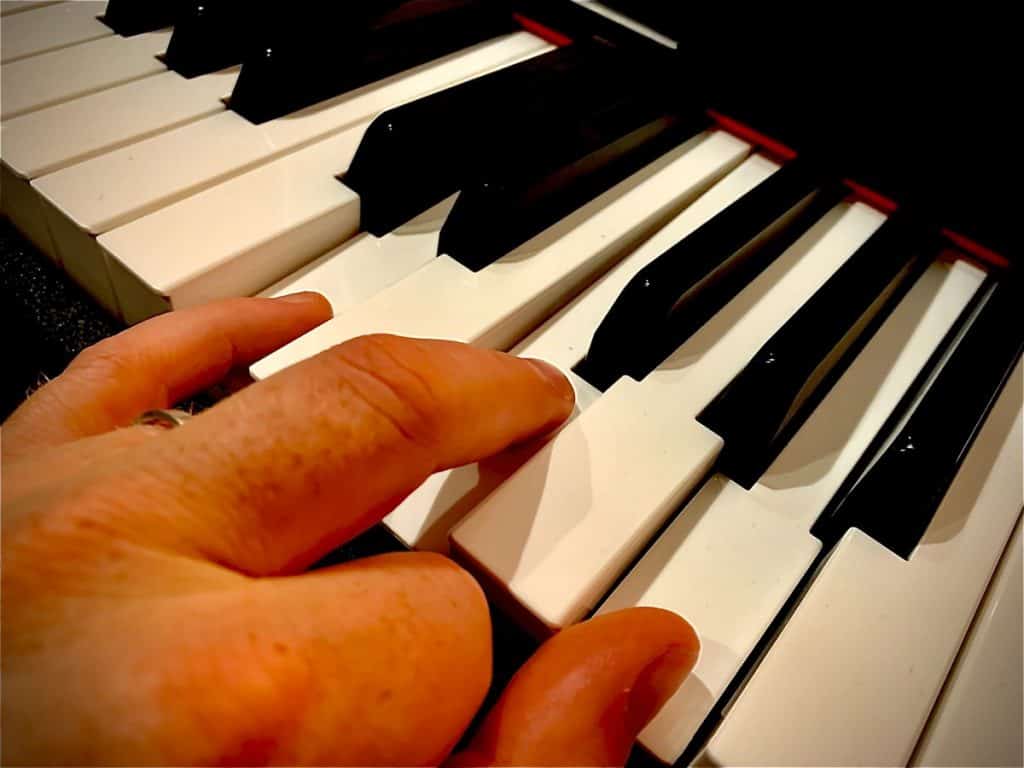
How To Play Piano - Summary
By now, you should be able to:
- Know every single note name on your piano or keyboard.
- You should be able to play a C Major scale, in the both hands separately.
- You’ll have learnt and practiced the thumb ‘tuck’ and ‘over’ technique.
- You’ll know the difference in sound between a major and minor chord.
- You’ll be able to play 24. -yes 24 chords in total! As long as you remember the formula.
Now it’s time to improve your technique…
Get the 4 Things I’ve Been Loving, Using and Reviewing
Instruments, Gadgets, Books and More…
Every Friday, I send out an exclusive email with the four most amazing things I’ve reviewed or used that week.
It could include exclusive giveaways or chances to interact with me, instruments, books, gadgets, music, new techniques/tricks, and — of course — all sorts of fun musical stuff I dig up from around the world.
These ‘4-Feature Friday’ emails are only available if you subscribe to my e-mail newsletter.
Read the next post in this series:
About the Author
Robert Emery
Robert Emery is Founder & CEO of Ted's List. He has performed all around the world as a conductor and pianist. From Sydney Opera House to the Royal Albert Hall, Robert has enjoyed bouncing around on stage in most of the major venues in the world. As a record producer, he has worked on fifteen No 1 albums, and hopes he can get to sixteen asap!
The Times called him 'the eccentric barefooted maestro' and the Mail quoted that 'the assured baton was controlled by the rather energetic and brilliant conductor'.
Robert has a wife (Mrs. E), two children (Master T and Master A) and four cats (Merlin, Mulberry, Partridge & Penguin). Between performing, producing, composing and running Ted's List, he runs an entertainment business called The Arts Group, comprising of a symphony orchestra, choir, live event production house, digital TV company and artist agency. Any spare time is usually devoted to sleep.
Other posts by this author




